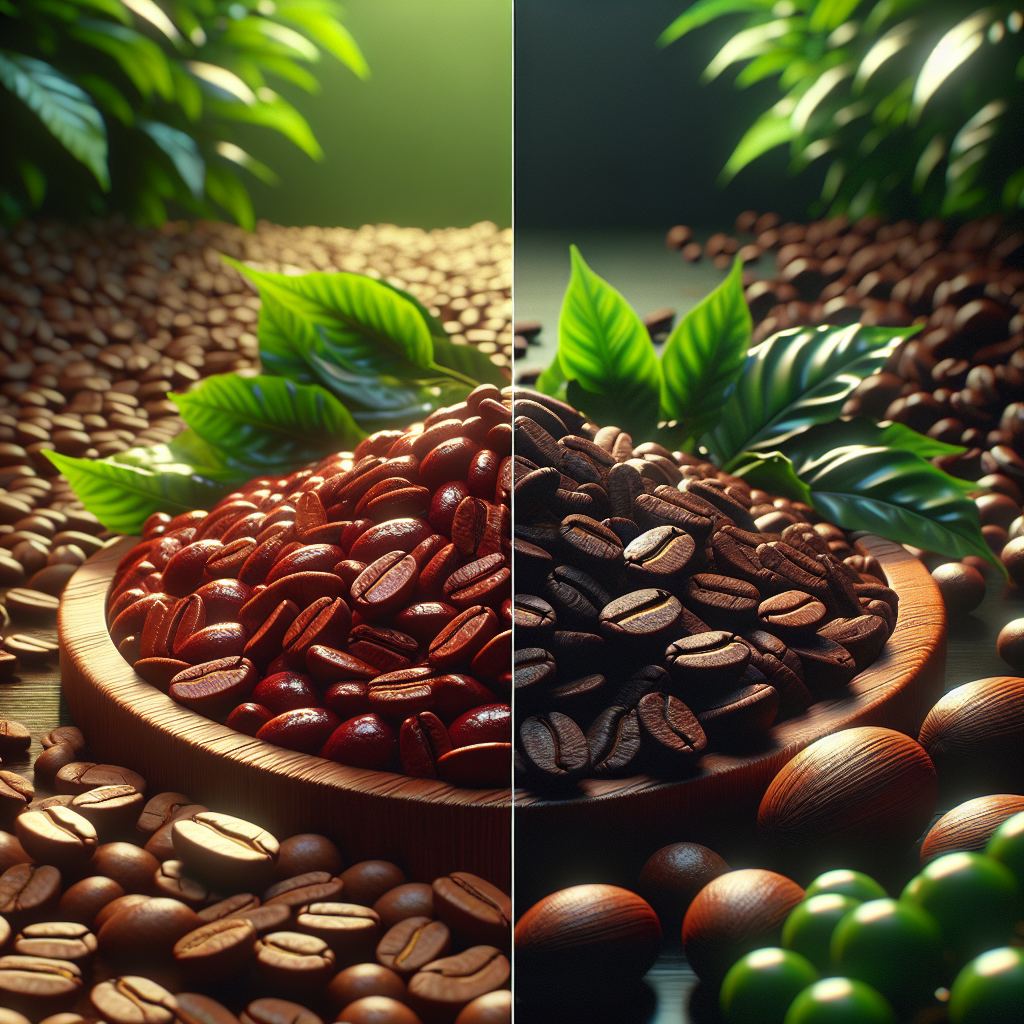Arabica vs. Robusta Coffee Beans: Detailed Comparison
| Characteristic | Arabica | Robusta |
|---|---|---|
| Shape | Oval and elongated, with a curved groove on one side | Rounder and shorter, with a straight groove |
| Flavor | Smoother, sweeter, fruity or floral notes | Stronger, intense, earthy, or woody flavors |
| Caffeine Content | Lower (about half that of Robusta) | Higher (about twice that of Arabica) |
| Growing Conditions | Thrives at higher altitudes (2,000-6,000 ft) | Grows well at lower altitudes (up to 2,500 ft) |
| Production Share | 75-80% of global coffee production | 20-25% of global coffee production |
| Price | Typically more expensive due to demand | Cheaper to produce |
| Oil Content | Higher oil content, richer flavor | Lower oil content, lighter brew |
| Usage in Coffee | Preferred for specialty coffees and gourmet blends | Commonly used in espresso blends and instant coffee |
1. Shape and Appearance
When it comes to identifying and distinguishing between Arabica and Robusta coffee beans, one of the most obvious differences is their shape. Arabica beans are typically oval and elongated, featuring a curved groove on one side. This distinctive shape results from the genetic traits of the Arabica plant. On the other hand, Robusta beans are rounder and shorter, with a straight groove running down the middle. These shape differences can influence how the beans roast and grind, thereby affecting the texture and final quality of the brewed coffee.
2. Flavor Profile
One of the most celebrated aspects of Arabica coffee is its flavor profile. Arabica coffee tends to have a smoother, sweeter, and more complex taste, often with fruity or floral notes. This complexity makes Arabica a favorite for specialty coffees and gourmet blends. Conversely, Robusta coffee is recognized for its strong, intense flavor, with earthy, woody, or nutty undertones. The higher caffeine content in Robusta adds to its bitterness, making it a popular choice for espresso blends. Understanding these flavor differences helps consumers select their preferred coffee bean.
3. Caffeine Content
The caffeine content in coffee beans significantly influences both the flavor and the physiological effects of the coffee. Robusta beans contain approximately twice as much caffeine as Arabica beans. This higher caffeine content contributes to the bold, robust flavor of Robusta coffee and also provides a natural defense against pests and diseases. Arabica, with its lower caffeine content, offers a milder and sometimes more palatable taste for those who are sensitive to caffeine or prefer a less intense coffee experience.
4. Growing Conditions
The growing conditions required for Arabica and Robusta coffee plants differ substantially. Arabica plants thrive at higher altitudes, typically between 2,000 and 6,000 feet, where the cooler temperatures and specific climatic conditions help develop their complex flavors. In contrast, Robusta plants are more resilient and can grow well at lower altitudes, up to about 2,500 feet. Their hardiness makes them easier to cultivate in various environments, which contributes to their widespread use in commercially blended and instant coffees.
5. Production and Popularity
Arabica coffee beans dominate the global market, accounting for about 75-80% of global coffee production. This dominance is a testament to the popularity and demand for Arabica, which is often considered superior in quality and flavor. Robusta beans, making up the remaining 20-25% of production, are essential in certain coffee blends, especially where a stronger flavor and higher caffeine content are desired. Understanding production statistics helps consumers appreciate the market trends and availability of these two coffee types.
6. Cultivation and Maintenance
Arabica coffee plants are more delicate and require specific climatic conditions, including cooler temperatures and careful handling during cultivation. These plants are also more susceptible to pests and diseases, necessitating more meticulous maintenance. Conversely, Robusta plants are tougher and can withstand harsher conditions, making them easier to grow and maintain. This difference in cultivation requirements often influences the cost and availability of Arabica and Robusta coffee beans.
7. Cost and Economic Factors
Due to their delicate nature and the specific conditions required for growth, Arabica beans are typically more expensive than Robusta beans. This price difference is primarily driven by the high demand for Arabica and its perceived superior quality. Robusta, being easier and cheaper to produce, is often more affordable. Economic factors such as demand, cultivation costs, and market preferences greatly influence the pricing and availability of both types of coffee beans.
8. Oil Content
Arabica beans contain more oils than Robusta beans, which contributes to their richer flavor and aroma. The higher oil content enhances the overall body and mouthfeel of Arabica coffee, making it more desirable for specialty brews. Robusta’s lower oil content results in a lighter brew, often perceived as less flavorful. The oil content in coffee beans can significantly affect the texture and sensory experience of the brewed coffee, influencing consumer preferences and brewing choices.
9. Brewing Characteristics
Arabica beans are generally preferred for specialty coffees and gourmet blends due to their smooth taste and aromatic qualities. The complex flavor profile of Arabica makes it ideal for various brewing methods that highlight its subtleties. In contrast, Robusta is often used in espresso blends and instant coffee products. Its higher caffeine content and ability to produce a rich crema make Robusta a popular choice for robust espresso shots. Understanding the brewing characteristics of each bean type helps baristas and coffee enthusiasts select the right bean for their desired coffee experience.
10. Health Aspects
The higher caffeine content in Robusta may provide more alertness and a stronger energy boost compared to Arabica. However, Arabica’s lower caffeine content could be easier on the stomach for some individuals. Both types of beans offer potential antioxidant benefits, which can contribute to overall health. Understanding the health aspects of Arabica and Robusta coffee allows consumers to make informed choices based on their dietary needs and health goals. For more coffee-related FAQs, visit here.
Summarizing the characteristics and differences between Arabica and Robusta coffee, it’s clear that each has unique qualities catering to various tastes, preferences, and needs. Whether you favor the complex flavors of Arabica or the bold intensity of Robusta, knowing these distinctions helps you make better-informed coffee choices. Explore more detailed insights and FAQs about coffee here.
Shop at Breville now!
https://breville.oie8.net/oqDqrE
Shop Coffee Machine at Amazon now!
Click here!





